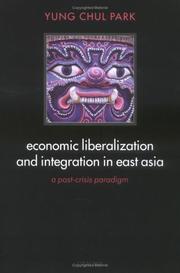Check nearby libraries
Buy this book

This edition doesn't have a description yet. Can you add one?
Check nearby libraries
Buy this book

Previews available in: English
Showing 2 featured editions. View all 2 editions?
| Edition | Availability |
|---|---|
|
1
Economic Liberalization and Integration in East Asia: A Post-Crisis Paradigm
June 22, 2007, Oxford University Press, USA
Paperback
in English
0199215219 9780199215218
|
zzzz
Libraries near you:
WorldCat
|
|
2
Economic liberalization and integration in East Asia: a post-crisis paradigm
2006, Oxford University Press
in English
0199276773 9780199276776
|
aaaa
Libraries near you:
WorldCat
|
Book Details
Table of Contents
Introduction 3
Characteristics and successes of the East Asian development paradigm 9
2.1. East Asian development models of four different generations 9
2.2. Accomplishments of the East Asian development model 14
2.3. Initial conditions, Asian values, and institutions 18
Development policies and governance 20
3.1. Market friendly policies 20
3.2. Interventionist policies and export promotion 22
3.3. The role of government and governance 27
Failures of the East Asian development model : an overview 33
Failures in governance and institution building 37
5.1. The breakdown of the governance mechanism 37
5.2. Institutional quality 40
Weaknesses of the corporate and financial sector 42
6.1. Corporate sector : the fall of East Asian corporations 42
6.2. Financial sector fragility : financial repression and crony capitalism 45
The Asian crisis : causes and consequences
The buildup of the crisis 55
7.1. Capital inflows and investment boom and bust 55
7.2. Structural reform and recovery 58
Causes of the East Asian crisis : structural weakness vs. liquidity panic view 63
8.1. Structural weaknesses 63
8.2. Were they the direct causes? 64
8.3. The liquidity panic view 69
A reevaluation of the IMF reform program : wrong diagnosis and wrong prescription 71
9.1. The IMF as a manager and lender of capital account crises 71
9.2. Multiplicity of reform programs 74
The IMF structural reform : inconsistencies in the program 78
10.1. Conflicts between structural reform measures 78
10.2. Wrong sequencing in financial and corporate restructuring 80
Institutional reform : challenges and prospects
Reform of government and industrial policy 87
11.1. The role of the government 87
11.2. Industrial policy and export orientation 88
Institution building for governance 96
12.1. Governance 96
12.2. Public sector malfeasance 102
Corporate sector reform : governance 105
13.1. Corporate debt workout 105
13.2. Restructuring of family-owned industrial groups 107
Social welfare and industrial relations 112
14.1. Social welfare 112
14.2. Democratization and labor participation 118
Financial liberalization and opening
Progress in and prospects for financial sector reform 125
15.1. Banks vs. capital markets in emerging economies 126
15.2. Reform agenda 129
Exchange rate regimes : fear of floating 134
16.1. Reluctant floaters 134
16.2. Intermediate regimes for East Asia 143
Capital account liberalization 149
17.1. Capital account liberalization and economic recovery in East Asia 149
17.2. Prospects for capital account liberalization 153
Economic integration in East Asia
Trade integration 163
18.1. Proliferation of bilateral ftas 163
18.2. Factors behind the proliferation of ftas in East Asia 167
18.3. Negotiated liberalization or protectionism? 168
Financial integration 172
19.1. The Chiang Mai initiative 172
19.2. The Asian bond market initiative (abmi) 178
Prospects for economic cooperation and integration in East Asia 185
20.1. Structural constraints 185
20.2. Trade integration 188
20.3. Financial integration 190
Reserve accumulation in East Asia and transpacific trade imbalance 195
21.1. Causes and potential consequences of the transpacific imbalance 195
21.2. Policy adjustments in East Asia : monetary and fiscal policy 202
21.3. Adjustment of exchange rate policy in East Asia 206
21.4. Intra-regional policy adjustments and coordination in East Asia 214
21.5. Inter-regional policy coordination 217
Whither economic liberalization and integration in East Asia?
In search of a new East Asian paradigm of development 223
22.1. What is left of the pre-crisis East Asian development paradigm? 223
22.2. Economic restructuring : is emerging East Asia halfway there? 224
A long road to Anglo-Americanization 229
23.1. Trade liberalization or export push? 229
23.2. China's economic ascent and economic liberalization in East Asia 231
New paradigm of development : a mixed economy model 235
Concluding remarks 242
References 246
Index
List of figures
Quarterly GDP growth rates 58
Transparency international corruption perceptions index 99
Real effective exchange rate 136
Daily exchange rate movements 137
Indices of financial liberalization by sector 151
Investment share in GDP 200
Saving share in GDP 200.
Edition Notes
Includes bibliographical references and index.
Classifications
The Physical Object
ID Numbers
Community Reviews (0)
Feedback?| August 1, 2020 | Edited by ImportBot | import existing book |
| July 29, 2014 | Edited by ImportBot | import new book |
| December 5, 2010 | Edited by Open Library Bot | Added subjects from MARC records. |
| April 28, 2010 | Edited by Open Library Bot | Linked existing covers to the work. |
| October 17, 2009 | Created by WorkBot | add works page |










